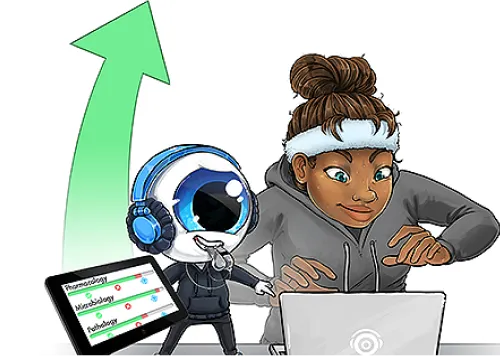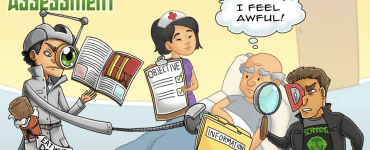Ever wonder about what the future holds for nursing education and its methods of delivery? Then you came to the right place. With recent technologies that advance and adapt to ever evolving healthcare needs, we are in a very exciting time for nursing education and practice. Read on for more!

Nursing Education Today
Let face it, the field of healthcare and nursing is always changing and evolving and nurses need to keep up to date with this change. This means our skills need to be on point, current and relevant. Nursing education is pivoting to ensure student nurses of today can adapt and lean into the healthcare of tomorrow. Supporting and engaging students with an online nursing curriculum that incorporates and relies on digital technology may present some challenges for educators. However, technology is here to stay in education and the aim is to promote foundational as well as advanced skills that help to prepare nurses to support patients with diverse and unpredictable needs.
As nurses, we often turn to evidenced based research to support our practice. Which means, as students we are taught to look for and integrate evidence based practice into our work with our patients. The exciting thing about healthcare is that it is always changing, and what worked 5 years ago may not be applicable today. Which is another great reason to keep up to date with current research and practices to ensure patient safety and healthy clinical outcomes.
Virtual reality and other means of simulation based learning, help to keep students engaged, focused and having fun. While also allowing learners to practice critical thinking and clinical skills in a controlled environment that allows for patient safety and security.
Methods that are memorable such as Picmonics have been found to increase student success and understanding of tricky content. As we are seeing more utilization of technology such as electronic health records and virtual simulation, we see the importance of nurses being competent in these digital methods and ensure patient privacy is paramount.
The Benefits of Blended Education
We are in an unprecedented time, where education can be presented to us in numerous and exciting ways. Blended education offers many advantages to the learner, as it allows for long established face-to-face in classroom instruction coupled with learning that is delivered online, via various platforms. This blended model allows for flexibility that can be both creative, engaging and flexible. This benefits students in many ways, as it allows for course content to be accessed at the convenience of the student.

For example, online discussion forums and virtual classrooms can be accessed at any time of the day or night, or even during lunch breaks and other times of convenience for the busy student. This then can lend to more student interaction, discussions and overall learning, retention and motivation. It also has the capacity to allow for concepts that may be complex for the student to be digested at an easier pace which will increase academic performance and overall understanding of the material. Such as our popular Picmonic on ADPIE which is a common topic covered in nursing school that nurses often apply to their practice throughout their career.
Another benefit of blended learning course work is the ability to become comfortable with digital technology right from the start. This allows new nurses the early exposure to navigate technology such as telehealth, electronic health records and other on-site interpreting software and technology that is on the rise in health care settings.
Tools And Technologies For Blended Learning
Blended learning is a hybrid model that combines traditional classroom instruction methods with online digital technology that allows for the learners to utilize various media tools that allow for learning to take place in a fun, effective and engaging format. Use of these tools promote avenues for the student to enhance their communication online and personalize their education in a way that works best for them. Blended learning may use platforms such as Moodle, Webinars, Zoom and Microsoft teams, as just a few examples.
Features may include quizzes, discussion forums, and even assignments that can be submitted online. Programs, like nursing that require students to interact in a “face to-face” format can easily use video conferencing tools like Google Meet, Zoom or Microsoft Teams as a way to support discussions that need to happen in a live lecture format which can even be recorded for students to listen to again to reinforce learning.

Other resources that can complement blended learning include Picmonics which allow for learners to interact and engage in material that is both fun and memorable. Students can learn need-to-know concepts that may be tricky, such as our Picmonic on hypertension medications, which is an important topic covered in nursing school.
Future Trends in Nursing Education
Why is virtual learning better and why should educators adopt a virtual learning system? Healthcare is constantly evolving and changing, which is driven mostly by advancements in technology and other digital platforms. Nursing education needs to keep up with this constantly evolving landscape by ensuring that new nurses are prepared for this ever changing healthcare environment.
Technology such as virtual and augmented reality are stepping in and revolutionizing how student nurses learn and are trained in the clinical environment, allowing for interactions with patients to be simulated in a safe and effective way. This way clinical skills and critical thinking can be improved without risking patient safety or compromising patient care.
With the rise of Telehealth and Telemedicine, Telehealth education is another trend that is increasing in nursing education. Skills learned may include remote patient monitoring training, how to effectively conduct virtual consultations as well as becoming skilled at the use of other relevant digital health tools. This way the future nurses of tomorrow can feel confident in delivering care through these platforms which are the cornerstone in healthcare delivery of today.
How Can Educators and Nursing Students Embrace the Future of Education and Learning
So how can we embrace the future of education and adopt these learning strategies and technologies in order to prepare future nurses for the demanding landscape of healthcare that is forever changing and evolving? How can we ensure students are retaining complicated facts while also reducing their stress levels? Engaging students with technologies that are integrated into course content and teaching methods is a great place to start. Methods such as virtual communities, online test taking options and even virtual patients are a fantastic way to allow learners to access materials whenever they want and need it.
Other effective methods include getting a headstart on teaching and incorporating tools that are already being used in healthcare such as telehealth training. This is important as it allows students to get educated on what this technology looks like as well as how and when to use it. Important aspects of telehealth use include confidentiality and privacy while gathering personal medical information. This is key and vital to nursing ethics.
Use of fun Visual Mnemonics are another great way to engage students. With our fact filled memorable Picmonics, students can be proactive in their learning to retain important information while enhancing and maximizing their educational experience.

Not only does incorporating this important technology into the classroom help students to retain content, it also promotes a culture of lifelong learning as it encourages students to adapt a mindset beyond the classroom setting and be prepared to use clinical best practices and current research into their healthcare practices. These practices allow for collaboration and critical thinking that best serves diverse patient communities and helps to build a nursing workforce that enhances timely communication, teamwork and is best prepared to meet the evolving challenges of modern healthcare.
If you are ready to put some of these study tips and tricks into practice and save time studying and boost your test scores, then start using Picmonic as your nursing study guide. Learn nursing with 1,200+ essential nursing school concepts in 2-3 minute mnemonic videos and have fun while you do it!
About the Author
Pamela Schutz, RPN, Medical-Nursing Scholar
As a registered psychiatric nurse with over 23 years of experience, in addition to coordinating events, managing social media platforms, and crafting compelling content, Pamela effectively conveys messages and drives participation. Pamela has the talent for simplifying complex ideas and making the captivating world of medicine less mysterious.













